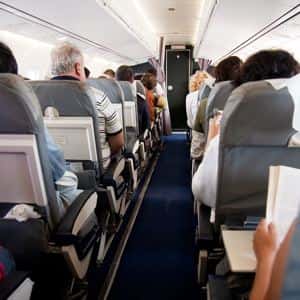
If you are traveling for summer vacation, it makes sense to pack soap or hand sanitizer where you can get to it easily. Car travelers may find that rest stops are not as well-equipped for hand-washing as one would like. Also, the handles and key pads on gas pumps can collect a lot of scary germs.
Germs in Planes:
Airplanes may harbor dangerous bacteria in unexpected places for a surprisingly long time. Travelers have long suspected that the recycled air makes it easier to catch colds or influenza. The confined space also makes it impossible to move away from someone who may be coughing or sneezing. As a result, air travel is perceived as an important way that diseases can be spread from country to country or continent to continent (Microbiology Spectrum, Oct., 2015). One study showed, however, that movement of passengers and crew within the cabin can have a significant effect on the circulation of microbes in the air (BMC Infectious Diseases, Aug. 6, 2014).
Experience with Ebola virus during the 2014 epidemic showed, however, that not all scary germs are readily transmitted during flight (Morbidity and Mortality Weekly Report, Jan. 30, 2015). The investigation covered three infected passengers who were on commercial flights. Despite careful follow-up of 247 possible contacts through those flights, no secondary infections were uncovered.
Persistence of Scary Germs:
Scientists at Auburn University in Alabama have just come up with another reason to worry. They studied components of an aircraft cabin and found that MRSA (methicillin-resistant Staphylococcus aureus) could survive more than 150 hours on the back pocket of an airplane chair. E. coli, which can cause intestinal infections, was viable for 96 hours on armrest material. These findings suggest that frequent hand-washing or disinfection with hand sanitizers would be prudent for air travelers who don’t want to pick up unplanned and unwelcome souvenirs.
American Society of Microbiology annual meeting, May 21, 2014
Other Considerations for Travel:
We’ve written here about a first aid kit for when you are away from home. It is a good idea to have it ready to go, and make sure that any prescription drugs you take regularly make it out of the medicine chest and into your travel bag before you leave the house!
Another problem that can cause air travelers consternation is ear pain, especially upon descending. There are a number of suggestions for calming this pain here.
Revised 6/16/16

